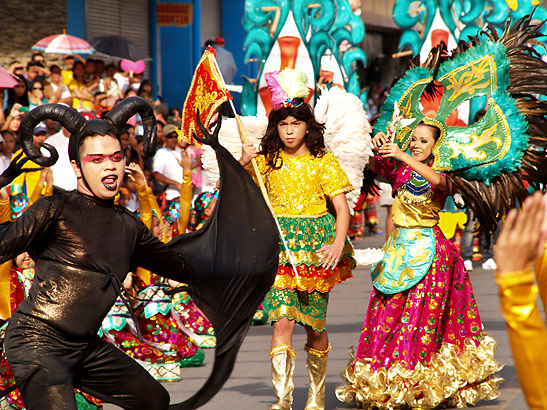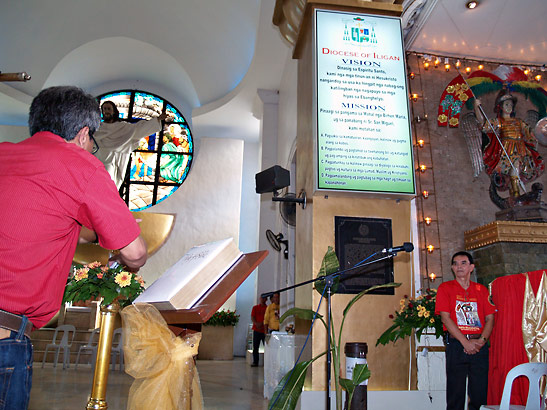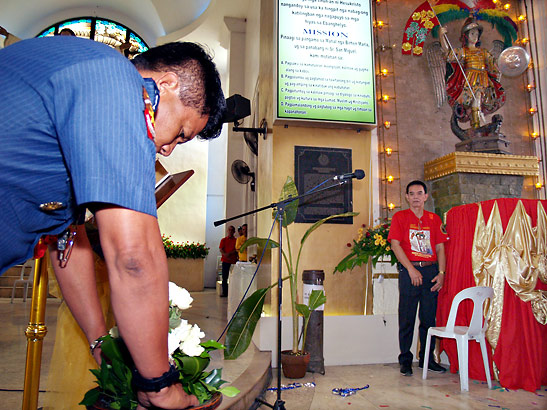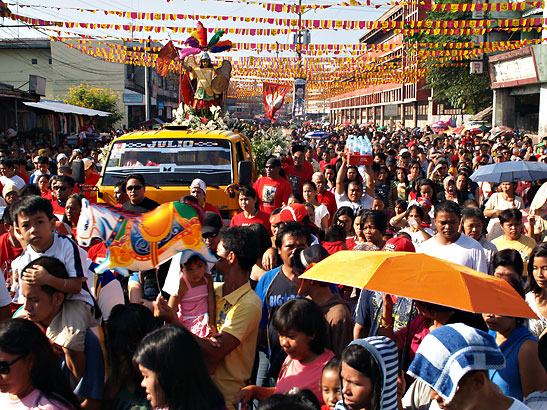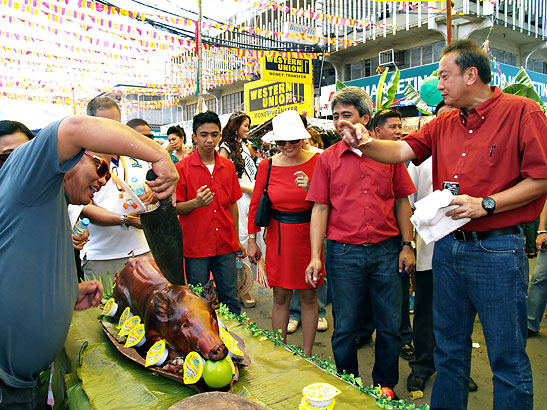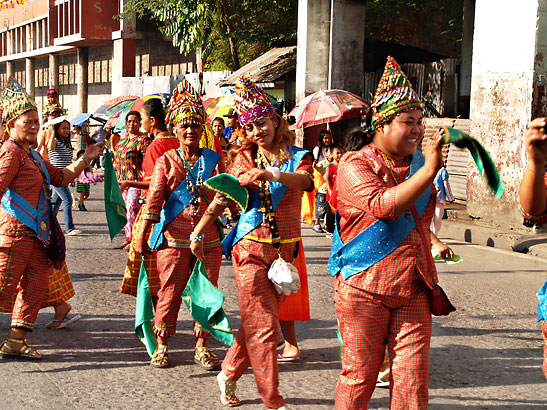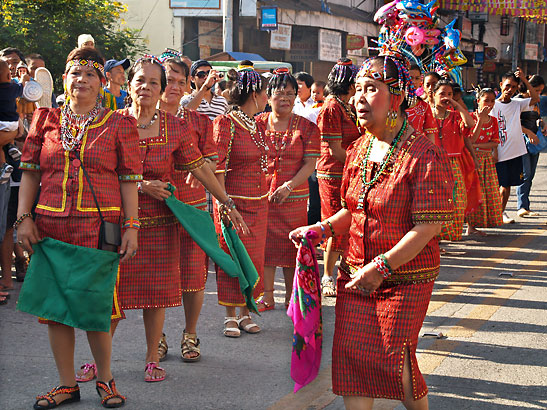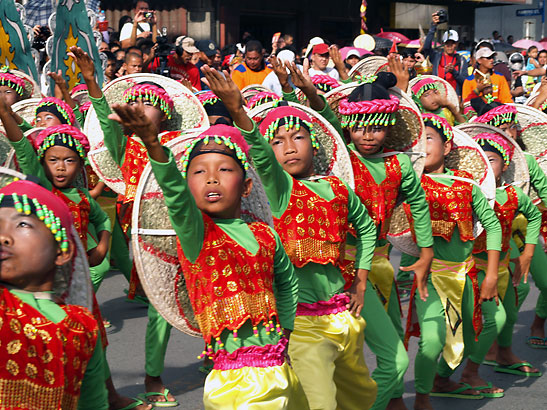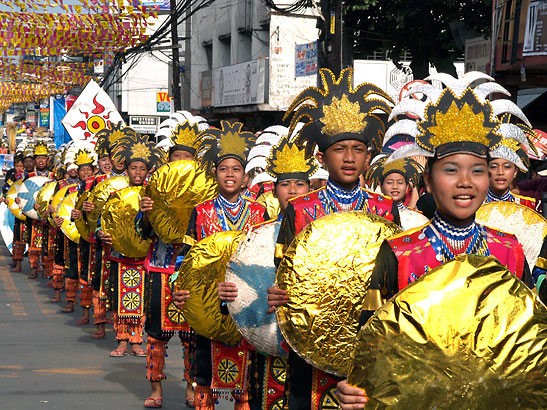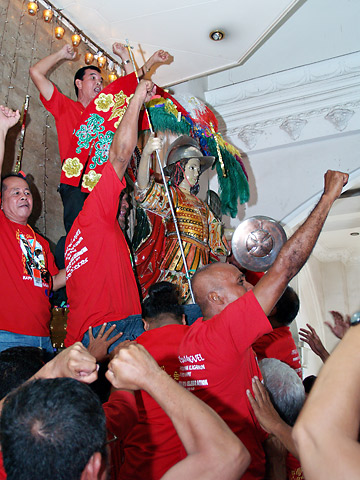 |
 |
|
 |

|
Traditions, Traditions,
Traditions!
Attending the celebrations after years of staying abroad, I was brought back to nostalgia. The tradition of bringing down the ancient statue of Saint Michael to the main altar for main viewing on the first day of the novena, started the festivities with a bang. Literally! There were heated discussions among the parishioners whether the ritual of putting on the helmet, cape and sword of Saint Michael as he is brought down should be followed or not. Traditionally, the honor of dressing the statue was always given to the town fathers. This time however, the bishop wanted to emphasize the separation of Chuch and State. The ceremonial donning of helmet, cape and sword was omitted.
There are always two sides of the question. “Tradition!” shouted one side. “Politics!”said the other. The dilemma of tradition pitted against modern times, is as old as when men started to organize themselves as a social unit. In the end, when all was said and done, a reasonable balance of power prevailed. The dressing up of the statue was done already when it was brought down to the altar, so there was no need for the Mayor and other government officials to take center stage and do the honors. Instead, the dignitaries were given place during the offertory of the Catholic Mass that followed. The Mayor, the Congressman, and the Chief of Police marched down the altar bearing symbols. The congressman carried the bible, the Mayor held a lighted candle, and the City Police Director had flowers. The latter was worth noting because the flowers symbolized peace.
The rest of the traditions went on… the street dancing, the pageantry of costumes, the culminating drama of the fight of the good angels led by Saint Michael, against the bad angels who followed Lucifer. It ended with the glorious victory of God’s forces of Light. All’s well that ends well. Viva, Senor San Miguel!
During one of the many celebration parties we attended, the conversation centered on the traditions in Iligan City which have faded away from memory. One of the lamented ones was the ringing of the church bells during angelus, which was 6:00 AM, 12:00 PM, and 6:00 PM everyday. It used to be that wherever they are, or whatever they happened to be doing, people would stop when the bells rung. They bowed their heads in silence and pray the Hail Mary angelus to honor the Virgin Mother. This only took a few minutes, but the pause was enough to remind the faithful of God’s presence in each life. I remember, as a child, that wherever my brothers and I would be, as soon as we heard the Angelus, we ran as fast as we could for home. If we arrived late for prayers, we were made to kneel an hour before the altar with our arms outstretched. (Not really an hour, because in those days, no one watched the clock.) The humiliation and the younger cousins smirking at our ordeal, was enough to shame us not to be late again. In retrospect, I believe this was a good way for parents to check that the children were home before dark. Perhaps, if we still had that custom now, there would be less juvenile crime. Who knows? Another way of checking on the older children, was the ringing of church bells at 8:00 PM. Unlike the angelus bells, this time, the bells sounded solmemn. “Gong! Gong! Gong!” To my child’s mind, it said, “The evil spirits will be roaming now. Go to bed! Go to bed!” My Mama would then tell us that it was time to say our good night prayers. I liked it best when it was my grandma, Lola Ica, who would tuck me to bed. She taught me this prayer in Visayan. "Angel kong magbalantay/ Santos kong sangay/ Imo akong bantayan/ Sa akong pagkatulog. Sa ulo ko ug ti-ilan / sa sigkakilid ko magtimbang / Si Jesus and akong guimatan…." The gist of the prayer was asking for God’s grace and requesting Him to send angels to watch over my sleep, with Jesus above me, Mary and Joseph on each side. Then I would shiver under my blankets so grateful to be snug in bed , well protected. I felt so safe and secure then. Speaking of Lola Ica, there is another tradition which makes me remember her so fondly. It was the “cantada.” Whenever it was the birthday of anyone in the family, she would wake up at dawn, then light the candles at the altar and wake everyone up. We would come in one by one, sometimes grumbling, sometimes just drowsily drop to the floor in front of the altar and go on sleeping. But we kids would soon awaken to the sound of singing. It was the “cantada” led by Lola Ica. With a strong voice she led the singing of praise to God, to thank him for the birth of ---- (Here, she would mention the name of the birthday celebrant) --- for making him part of our lives. Then everyone joins in the singing of praises to God, his angels, his saints , followed by the Ave Maria. Looking back, I see now the importance of the cantada in the family. It made each one who celebrates a birthday feel esteemed. One may have rough times or feel ignored in the family at certain times in the year. But when one’s birthday comes, we can be sure that everyone remembers. As the family prays together for you and your life, you feel important. The mellow voices soft in the cool dawn, the candles lit on a dim altar; the lightening sky seen through the window; and the solemn faces of family members who gave up their sleep to thank God for you... What a manifestation of family love. Thus, we in that party talked of tradition. But actually, I think, we were thinking and missing the family ties and community customs that held us when we were growing up. That life style only lives in memory now. But those of our generation who were part of it will always remember, and smile. Viva fiesta!
Related Articles: |
|
Feedback for"Dia delos Muertos" It sure captures the essence of this well loved tradition, "Todos
Los Santos"/"Dia de los Muertos" celebrated with the ambiance,
flavor and hoopla making it more fun in the Philippines than elsewhere in the
world. * * * * * * * * * * Feedback for"Bleeding Hearts" You threw everything on this one; juicy items/ chismis
(gossip) about controversial politicians in the running, and role of tears to
draw public sympathy/ attention and hopefully votes.... 'Only in the Philippines!" * * * * * * * * * * * * * * * "Congrats on your interesting columns which never fail
to arouse interest. That's a new angle on tears from politicians. To be sure,
this makes a good story. Crocodile tears go well with a politician's strategy.
Keep the columns going!" You captured the flavour and the various nuances of the major fiesta in Iligan City, that of St. Michael. I like how you managed to adroitly weave in vignettes of your family life --- customs and practices to make the readers aware that once upon a time, life was beautiful. Your description of the early morning prayers and songs dedicated to the birthday celebrant of the day, reminds me of the Mananita of the Manila cursillo days in the 60's and 70's. In fact, I remember when I was in Iligan for the first time, to join your family in celebrating your Mom's 96th (?) birthday, we were roused from sleep by the strums of guitar which accompanied the mananita song of the group of farm hands/tenants greeting your Mom a rousing Happy birthday. Thanks for sharing lovely bits and pieces of your life. --- Chita Almario, Alabang, Metro Manila, Philippines I enjoyed your reminiscences of fiestas in your childhood and youth, and family traditions, particularly that of lavishing the birthday celebrant with the love and attention of the whole family for that one special day, starting with the mananita. The pictures added impact to your article. I always marvel at how cities and towns in the Philippines can come up with lavish costumes during their fiestas. Think of the money, time and effort spent in preparing these street dancing, parades, etc. --- Evelyn Peplo, Quezon City, Philippines For "Traditions, Traditions, Traditions!" - One of my college choirs is singing a very rarely sung Anglican anthem for our Festival of Lessons and Carols is this December: Fanfare for Michaelmas Day--the account from Scripture of Michael defeating the dragon. What a coincidence. The beauty of these traditions was that faith and living were indeed one. One informed the other. However, things became different when the church and the state became separated entities. I think that there is so much to be learned from both situations so that they need not be opposed to each other, but are truly two sides of the same coin, with the emphasis on "same coin" rather than "two sides." --- Joel Navarro, Doctor of Music Arts in Conducting Dear Joel, How interesting that you are involved with a song about St. Michael. Thanks for sharing. You say it is an Anglican anthem. I wonder how it sounds? It interests me because part of the fiesta tradition here is the staging of the fight of the good angels vs. the bad... all done in song like an operetta. I think the songs have been handed down from Spanish times, althogh translated in Visaya [a Philippine dialect]. I am curious how the Anglican music and the Spanish would compare. In the Iligan version, the opening song of Michael the archangel with his warrior angels is majestic with a regular marching cadence , while the entrance of Lucifer and the devils is lively. Their beat is merry, with the devils cavorting and singing. This would bring screams of frightened delight from the kids in the audience. If this were a broadway play, the devils with their red costumes, horns and tails, would be a "show-stopper". Thus, the way of the world , eh? But of course, the angels have their glorious victory in the finale. And the angels all handsome, with white wings that glittered, march down the street in a clash of cymbals and drums. I think the color and contrast of this ancient music would amuse you. --- Dette
For "Few Mountains Left to Climb" (Manny Pacquiao) - I saw the Pacquiao fight and without a doubt, Manny is the greatest fighter of this generation and one of the world's greatest sportsmen. Everyone will continue to ask if he can go out on top by fighting Mayweather before he retires. --- Richard, Miami FL
For Camiguin Island, Philippines. - I love the White Island on Camiguin Island. Reminds me of the time when I was at the Heymann Islands off the coast of Australia and the Great Barrier Reef....wow, I love those low tides. .I'm also interested in old pre-war style houses. I'm thinking of a place like that when I retire . I will get there sooner than you think. --- Mel Odilao, Washington D.C. * * * * * You made me feel nostalgic ....I was there with my daughter three years ago. It was unforgettable; I still fantasize about going back again, hopefully sooner than much later. Congratulations , your articles on very appealing format. Thanks to whoever did the digital features of high-tech. Keep it up for everybody's pleasure. --- Rita Adkins, Maryland. * * * * * Nakakaingit! (Wish I were there!) This is beautifully done. Photos, map, nicely situated in the article. Congratulations. The lay-outting is so professional. --- Precious Javier, Los Angeles , CA. * * * * * Thanks for sharing the beautiful scenery of Camiguin Island. I will put that on my list of places to see. --- Anita Sodusta, Ventura County, CA. * * * * * Thank you for this lovely account. Left my mouth watering for the lanzones and me pining for the chance to go there. Forwarded the article immediately to a couple who like us spend winter months in the Philippines. We had been discussing a trip to Camiguin when we go in January. But perhaps we should do that during lanzones season, October to November right? Would you permit me to forward your article to a friend who might want to publish it in our local Philippine newspaper? I wish to entice Filipinos in U.S. to explore the rest of the Philippines, rather just stop in Manila. --- Eduarda Macaranas, Washington, D.C. Anytime of the year is a good time to visit. In fact, off-seasons, hotel accommodations may be cheaper. Aside from lanzones, Camiguin has other sweet fruits to offer like mangoes and tropical bananas that tastes so good when cooked in coconut milk and panocha. (brown sugar, freshly made from sugar cane juice.) They are available year round. Publishing to your local newspaper is a great idea. --- Dette * * * * * Sounds like Camiguin Island is a paradise to behold. But I was struck by the awesomeness of the narration; beautifully written and emotionally laden. Terrific impromtu haikus too. Thanks for sharing this. --- Pete Recinto, Virginia Thanks for joining our Elago bash. Dette, I do love your article for Traveling Boy. You captured the spirit of our togetherness in your article. How could we ever forget this blessing! Here’s my own haiku contribution to that adventure: “ White Island beckons/ Dazzling in the horizon/ Captivating hearts.” May I use some historical tidbits on Camiguin which you cited in your article? I can use this for my own account of the Elago reunion. Besos y abrazos, --- Aida D'Orazio, Toronto, Canada Of course, feel free to use the article. Since it is now the property of “Traveling Boy”, just be sure to acknowledge this. Thank you once more. The pleasure of joining your family reunion was ours. --- Dette * * * * * How beautiful and heartwarming is your column, Dette, like a poet voicing her sentiments. It is well written and researched. That part about the little boys was especially touching. Tigidig tigidig echoes in my mind and heart. Bless those boys. May their angels always keep them safe. May they love and serve the Lord. Our Mindanao sojourn will remain in our memory for years to come. Thanks to you and Aida and Chita, everything came together. --- Evelyn Peplow, Quezon City, Philippines * * * * * Thanks for writing such a beautiful article. I felt envious for not being there with you, nostalgic for a place I have not been to , and wishing I could write haiku as easily as you all did . --- Tina Aragon, Maryland * * * * * This is probably one of my favorite pieces that you've written so far. You write so well...the whole "tigidig tigidig" thing interwoven throughout--very nice touch! --- Pia Hugo, Los Angeles, CA * * * * * Thank you for this poignant and lively travelogue. To write so regularly, have an active lifestyle, enjoy friends, and travel with such adventure is good modeling behavior for all of us in the middle years. We are a blessed humanity to know that God's green earth is always full of magnificent surprises. We are at wonder at every turn, and the people we meet on the road are virtual mirrors that reflect his image. --- Joel Navarro, Grand Rapids, MI * * * * * I'd like you to know that your captivating article on Camiguin for Traveling Boy is more than a travelogue as you portrayed the charm, the essence and the mystique of the island born of fire. I loved the way you ended it, on a poignant note: the refrain of tigidig by the little diver boys which left us misty-eyed as the ferry pulled away from the pier; this segued on to the tale from Polynesia about leave-takings. This is exactly how I felt when we said our good byes. --- Chita Almario: Alabang, Metro Manila, Philippines * * * * * I thoroughly enjoyed the vicarious pleasure of reading about your Camiguin adventures and the pictures, not to mention the haikus. You even gave us a historical perspective . --- Blanche Gallardo, Alabang, Metro Manila * * * * * Your words were so picturesque and your details included lots of local color. It made me want to visit Camiguin. love it, --- Hannah Suderland, Monrovia, California
For The Cherry Blossoms of Washington D.C. - Hi ...I was surfing the net looking for leads to Blanche Gallardo and found your interesting piece on the Cherry Blossoms of Wash. DC. It seems that the original idea for flowering trees in the capital came from Mrs. Taft herself... who reportedly missed the sight of the annual blossom display of similar trees when her husband was stationed in Manila as governor general. My scholarship is in Manila's urban history and the only possible strand of showy trees then would have been either the wonderful acacias (samanea saman) on what eventually became Taft Ave. or the fire trees (delonix regia) on P. Burgos leading from the old Plaza Lawton to Luneta and the Manila Hotel - this was the route that Mrs. Taft would have taken for late afternoon paseos at the Luneta. Cheers, --- Paulo Alcazaren , Manila, Philippines * * * * * Your article was an appeal to my senses. How romantic! After I've read your article, I remember the beautiful cherry blossoms in the movies Memoirs of a Geisha and of course The Last Samurai. --- Elsie, Iligan City, Philippines * * * * * What a feast for the senses indeed! Wish you could do the same thing about autumn in Canada. --- Aida, Toronto, ON * * * * * Yep. Pollyanna you might be but I couldn't agree with you more about "How so much more harmonious this world could be if nations exchanged plants instead of bullets." I say amen to this! --- Blanche Gallardo, Manila, Philippines * * * * * Words give life to pictures. You do it so well! Thanks. --- Tina, Hagerstown, MD
Dear Dette, I enjoyed reading your articles, especially the philosophical musings. --- Dading, Washington D.C. * * * * * Dear Dette, Your articles make me feel good about life. I enjoy reading them and look forward for more. --- Arabella, Maryland
For Dolphins Ahoy! - Dear Dette, Thanks for your fascinating article about the dolphins. You raise a thought-provoking question about how they got to drift to that unusual part of the Pacific Ocean. Certainly raises serious questions about environmental factors that may be the cause. I just read last night some stats -- one claiming that human consumption and lifestyle impact the ecological environment resulting presently in the demise of other living forms about 1000 more times than the recorded average. That's a pretty astounding estimate !! In my RP [Republic of the Philippines] visit in 2000, I went to Mindoro and observed -- to one's dismay -- that non-biogradable items such as the common plastic containers and the like that we use and generally throw away anywhere, not to mention real toxic industrial and medical waste, end up in the shore of that beautiful seaside barrio of about 400 families, ruining not only the view but the life of several sea-based creatures, including whatever edible fish and seafood that the barrio thrives by. Obviously, the small population could not have consumed that vast amount of plastic, etc. It turned out, I was to learn, that the waste comes from tthe garbage dumps of urban parts as far as heavily populated Manila, as well as the garbage dumped by passenger vessels that ply the inter-island routes --- with, obviously, no regulatory disposal systems. --- Rita, Virginia
|
![]()
Stay tuned.
This site is designed and maintained by WYNK Marketing. Send all technical issues to: support@wynkmarketing.com

|











